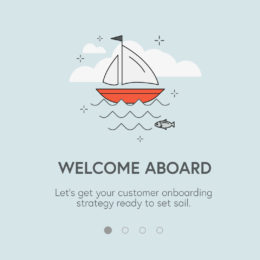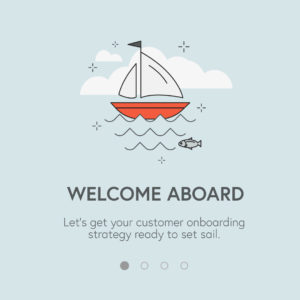Are Your Customers Jumping Ship?

3 ways to get customers on board with your brand.
The following blog post was written by Maggy Stewart, Graphic Designer & Marketing Coordinator at RMS.

How important do you think it is to make your customers happy and keep them coming back for more? Your answer to that question is the answer to how important successful customer onboarding is. Onboarding is showcasing the value of your product or service to your users, how they can make the best of it, and most importantly, listening to your customers’ questions and concerns and answering them to make their experience as enjoyable and seamless as possible. When it comes to consumer onboarding, we know that losing customers can be extremely costly to your marketing budget and your reputation. Not only does the loss of new customers cost a lot of money, it also demeans their lifetime value, making it extremely important for you to analyze data to discover where they’re dropping off and why. So where should you start when it comes to constructing an onboarding strategy, engaging and retaining customers and making the most of your marketing tactics? Here we break down three intuitive steps to get your customer onboarding strategy ready to set sail.

There are multiple companies out there that provide a product or service identical to yours. What sets you apart are the experiences you offer throughout the onboarding process. The customer experience (CX) focuses on generating positive social interaction between the consumer and your brand. The user experience (UX) encompasses all aspects of the customer’s interaction with your company, services and products through a functional and intuitive application and design. The brand experience relates to the emotions or behavioral responses evoked by your brand’s design, identity and communications. To your marketing team, these three experience categories differ, but to the customer — and this is important — they are the same thing. Ensure your brand experience, UX and CX are fully integrated. A stronger, cohesive interaction between your marketing and experience teams means a better onboarding experience for your customers. Your marketing team can fix or strengthen the onboarding process because they understand the brand and customer journey. Use their expertise to optimize your marketing budget and content strategy, ensuring that no customer journey touchpoint is ignored.

Have you launched a new product but are finding your customers aren’t using it? Have an app that’s getting downloads but no one’s operating it? You may have been able to secure a new customer through a successful marketing campaign, but nearly 10% of newly acquired customers fail to complete onboarding, which can cost businesses nearly $550,000 of marketing spend per year1. This disconnect varies from business to business, but you need to start with a clear understanding of your customer’s journey. the best way to do this? Ask them. Conduct market research to analyze patterns and define individual customer journeys from start to finish. Interview and survey your customers to see what touchpoints could be improved, removed or added. Consider heatmapping your website to decipher user behavior on specific web pages, where they’re clicking and how far they’re scrolling down your pages. Figure out where the drop-off points are by walking through the entire process with them, from initial use, to purchase, to product or service usage. If your customers can’t finish what they set out to accomplish, they will drop off, and they will look elsewhere. The more seriously you consider their journey and satisfaction, the more likely you are to obtain and retain a gratified customer base. Your customer’s experience is your biggest selling point during the onboarding process.

The value of retention compared to acquisition is often overlooked. Following your research to understand what your customer’s definition of ‘success’ is, take the time to really consider what your proper onboarding strategy should be, ensuring the customer achieves their desired outcome. This is where retention comes from. After you ask your customers about their entire experience — from navigating through your site, to purchasing a product, to app or software utilization, to continuous and prolonged use — you’re set up to efficiently gauge what their desired outcome is and if they’re succeeding in reaching it. If they’ve purchased your product or downloaded your app, engage with them to see how it’s working for them or if they need help making the most of your product or service. Think of subscription video on demand (SVOD) services like Netflix or Hulu. They typically begin the onboarding process by offering a 30-day free subscription as an attempt to convert consumers into paying customers. If these consumers don’t see the value or potential of the service, they’re not going to convert to a paying customer. But engaging with them throughout their personal onboarding process (sending emails or in-app messages that guide them toward their personal preferences, or inviting them to submit profile specifics to personalize their experience) will promote a more personal and therefore higher level of customer satisfaction, closing that dreadful drop-off rate every business strives to avoid.
1 Forrester.com, Focus B2B Marketing Budget Gains on Business Outcomes to Succeed in 2014.
RMS is a full service market research and consulting firm located near Syracuse, New York. If you are interested in learning more about our market research and customer experience capabilities, please contact Sandy Baker, our Senior Director of Business Development & Corporate Strategy at SandyB@RMSresults.com or by calling 866.567.5422.